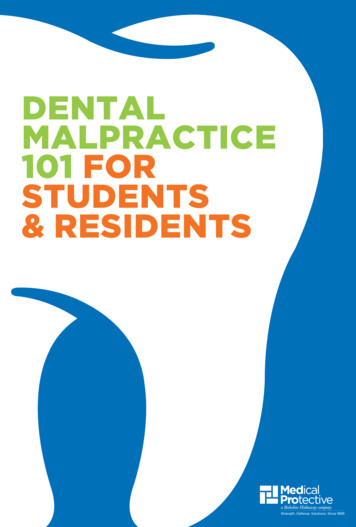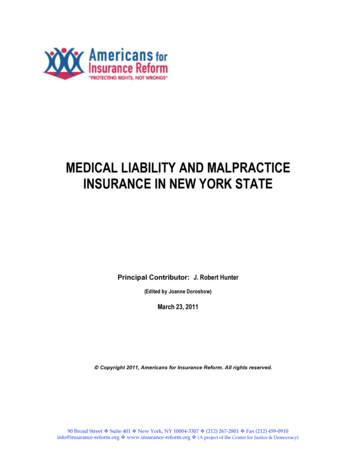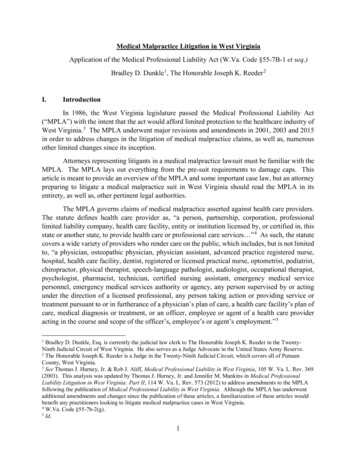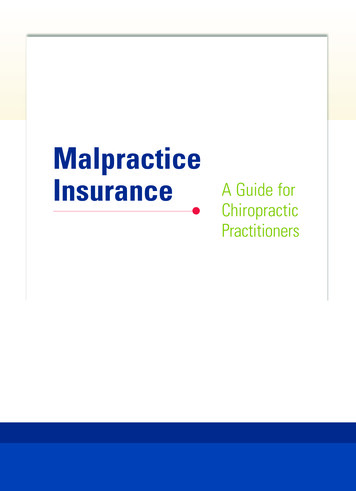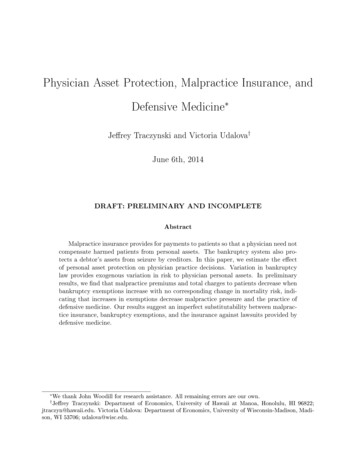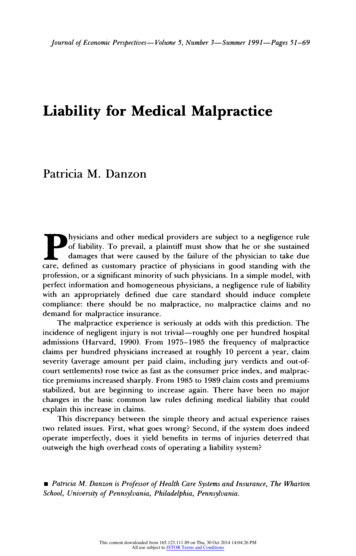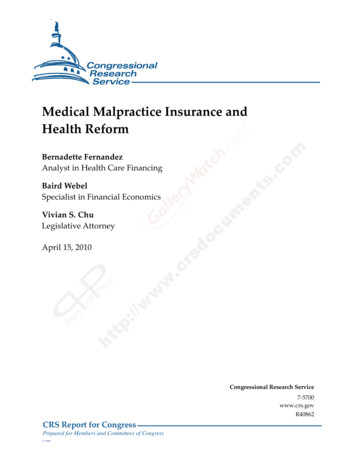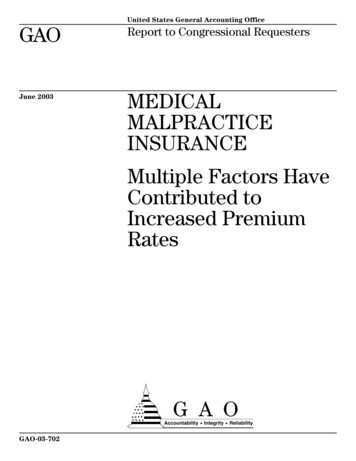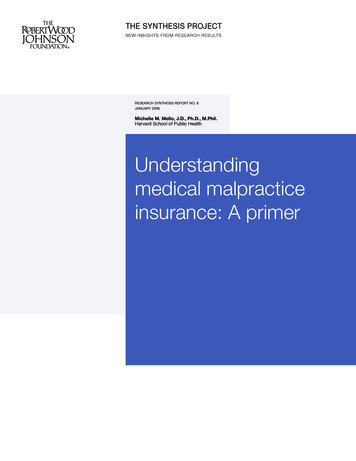
Transcription
THE SYNTHESIS PROJECTNEW INSIGHTS FROM RESEARCH RESULTSRESEARCH SYNTHESIS REPORT NO. 8JANUARY 2006Michelle M. Mello, J.D., Ph.D., M.Phil.Harvard School of Public HealthUnderstandingmedical malpracticeinsurance: A primer
TABLE OF CONTENTS1Introduction1How does medical malpractice insurance work?4How much do we spend on the malpractice system?4What is a medical malpractice “crisis”?8What causes malpractice crises?APPENDIX13 Appendix I ReferencesTHE SYNTHESIS PROJECT (Synthesis) is an initiative of the Robert Wood Johnson Foundation toproduce relevant, concise, and thought-provoking briefs and reports on today’s important healthpolicy issues. By synthesizing what is known, while weighing the strength of findings and exposinggaps in knowledge, Synthesis products give decision-makers reliable information and new insights toinform complex policy decisions. For more information about the Synthesis Project, visit the SynthesisProject’s Web site at www.policysynthesis.org. For additional copies of Synthesis products, please goto the Project’s Web site or send an e-mail request to pubsrequest@rwjf.org.SYNTHESIS DEVELOPMENT PROCESS426POLICYIMPLICATIONS13Scan FindingsAudience Suggests TopicWeigh EvidenceSynthesize Results5Distill for Policy-MakersExpert Reviewby Project Advisors
IntroductionAs the policy debate over the medical malpractice insurance crisis continues, dueling claims aboutits causes and suggestions for policy solutions have highlighted the need for a better understanding of how medical malpractice insurance works, why premiums change and what can be doneabout it. This policy primer provides a basic description of these issues, focusing on the followingquestions: How does medical malpractice insurance work?How much do we spend on the medical malpractice system?What is a medical malpractice “crisis”?What causes malpractice crises?This Primer is one in a series of reports addressing medical malpractice insurance issues. Theseries also includes a Research Synthesis and Policy Brief analyzing research evidence onhow the medical malpractice crisis has affected health care delivery and the impact of statetort reforms.How does medical malpractice insurance work?Most health care providers need to buy professional liability insurance. Nearly allstates require that physicians have liability insurance. Even in states that don’t, physicians usuallyhave to have insurance coverage in order to get privileges to see patients at a hospital. In somecontexts, however, physicians can choose to “go bare.” In Florida, for example, it is estimated thatabout five percent of physicians carry no liability coverage (17).Physicians usually buy their insurance from a commercial company or a physician-owned mutualcompany, either individually or through a group practice. Hospitals and other health care facilitiespurchase their own insurance, and hospitals that directly employ physicians typically buy a policythat covers both the hospital and its medical staff. Physicians employed by the federal government don’t buy insurance; if they are sued, the suit is brought against the federal government,which insures itself. Some state-employed physicians receive coverage from the state.Premiums for malpractice insurance vary with the provider’s degree of risk, butexperience rating is not widely used. Insurers set premiums on a prospective basis basedon: 1) their expected payouts for providers in a particular risk group; 2) the uncertainty surrounding this estimate; 3) their expected administrative expenses and future investment income; and 4)the profit rate they seek. They use information on past losses and expenses, combined with otherinformation, to help them set rates.Physician professional liability insurance does not work like auto insurance, which is generallyexperience rated. When a motorist has a claim, his insurance premiums go up. Physician malpractice premiums, by contrast, are usually priced according to the physician’s specialty andgeographic location only (some insurers also consider number of hours worked and types andsetting of work within the specialty). Experiments with individual experience rating have notworked because physicians’ claims experience is too variable over short time periods, making itdifficult to produce an actuarially stable estimate of their risk.For hospitals, some degree of experience rating occurs, but usually no more than 25 percent ofthe hospital’s total premium is based on experience. Experience rating hospitals is more feasiblethan experience rating physicians because hospitals’ claims experience is more stable over time.Hospital premiums also vary with hospital location (e.g., urban versus rural) and the clinical services offered (e.g., level of trauma care).Understanding medical malpractice insurance: A primer THE ROBERT WOOD JOHNSON FOUNDATION RESEARCH SYNTHESIS REPORT NO. 8
How does medical malpractice insurance work?On average, it takes four to five years to resolve a claim from the date of an incident(23). In many states, plaintiffs can wait two or three years after discovery of an injury that allegedlyresulted from malpractice to file a claim. This long tail means that insurers have a lot of uncertaintyabout what their liability ultimately will be. The difficulty of estimating liability for claims that havenot yet been brought or resolved makes it hard for insurers to set premiums accurately.Although recently a federal legislative issue, like most kinds of insurance,malpractice insurance is regulated primarily by the states. State insurancecommissioners regulate rates to ensure that they are not excessive, inadequate or unfairlydiscriminatory. Variations in this state-specific regulation are one reason that premiums maygo up (or down) in some states and not in others.State departments of insurance follow one of six types of insurance regulation for medical liabilityinsurance (Figure 1). Some make it harder than others for insurers to change their prices (23).Even within these six statutory approaches, there can be significant variation in the actual amountof oversight by the insurance commissioner. The commissioner may be relatively stringent orlenient in approving rate changes and more or less diligent in reviewing submitted materials.Figure 1. State approaches to medical malpractice insurance regulationInsurance regulation approachMostrestrictiveLeastrestrictiveHow it worksPrior approvalInsurers must file proposed rate changes with the state andobtain approval before the changes can be implemented (17states in 2004).Modified prior approvalRequires prior state approval for rate revisions based on achange in the insurer’s expense ratio.Flex ratingRequires prior approval only if the rates exceed a certainpercentage above (and sometimes below) the previousrates.File and useRequires that insurers notify the state of rates prior to theiruse, but does not require specific approval (23 states).Use and fileRequires that the state be notified after rate changes areimplemented (9 states).No fileRequires insurers to maintain records of information usedin developing their rates, but does not require them to filenotice of their rates with the state.Source: Nordman et al., 2004. Source does not list the number of states using the modified prior approval, no file, or flexrating regime.Rate regulation may have an important influence on insurance prices, but whetherit raises or lowers them is not clear. In theory, regulation could keep prices higher or lowerthan they would be in an unregulated market. Prices could be higher if regulators set price floorsin an effort to protect consumers against companies becoming insolvent because they droppedtheir rates too low and incurred liability they couldn’t pay for. They could be lower if regulatorsrefused to approve rate hikes in response to pressure from consumers to make insurance moreaffordable. Studies of auto insurance have provided support for both these hypotheses (6). Nocomparable studies of the professional liability insurance markets are available. RESEARCH SYNTHESIS REPORT NO. 8 THE ROBERT WOOD JOHNSON FOUNDATION Understanding medical malpractice insurance: A primer
How does medical malpractice insurance work?Several important recent shifts in the liability insurance market have affected howmuch health care providers pay for insurance and the amount of exposure they face.Exit of some commercial carriers and advent of physician mutuals—Physician-owned-andoperated companies (mutuals) sprang up in the 1970s and 1980s to fill gaps left by the exitof commercial carriers. Mutuals may offer lower rates than commercials and give physiciansgreater control. Some mutuals with little underwriting expertise have faltered during hardmarkets, however,Problems obtaining affordable reinsurance after September 11—Reinsurance, which covers lossesabove a specified threshold, helps organizations limit their exposure in a given year. Reinsurancehas become more expensive for both self-insured hospitals and insurers during the most recentmalpractice crisis. Along with other factors, the catastrophic losses that reinsurers suffered onSeptember 11 made reinsurance more expensive. When reinsurance costs more, primary insurers’profits decline unless they pass along the increase to those they insure.The growth of hospital self-insurance—Instead of opting for commercial insurance, many hospitalsare forming captives (companies that are wholly owned by a single health care facility or hospitalsystem) and other self-insurance arrangements in order to exert greater control over rates andleave a risk pool that includes higher-risk facilities. The downside is that self-insured hospitalstend to retain more risk, particularly if they have trouble finding affordable reinsurance. Also,prices in the commercial market may increase when lower-risk members leave the pool.Shift from occurrence policies, which cover all incidents in the policy year regardless of when theclaim is filed, to claims-made policies, which cover only claims filed in the policy year—Coverageis more meager under a claims-made policy; it leaves a long tail of exposure for incidents thathaven’t yet become claims. Most physicians purchase costly tail policies to cover these incidents,in addition to paying for a claims-made policy.Increasing interest in hospitals buying insurance for doctors—By affiliating more closely withhospitals, some physicians have been able to find a stable, relatively low-cost source ofinsurance. This trend has widened the disparities between physicians who practice in largegroup settings and those in small-group or solo practice settings, who are more vulnerable tofluctuations in overhead costs.The growth of joint underwriting associations (JUAs) and patient compensation funds (PCFs)—JUAs are state-mandated insurers of last resort for physicians who cannot find insurance on themarket. If the JUA’s losses exceed the premiums it collects, other insurers in the state are requiredby law to contribute toward covering them. PCFs are state funds that operate like an excesslayer insurer—that is, if a judgment exceeds the physician’s primary policy limit, the PCF paysthe amount above the limit (or the amount between the limit and another statutorily-prescribedamount). They are funded by mandatory surcharges that physicians and hospitals pay on theirprimary-layer policies. These arrangements give primary insurers, physicians, and hospitals anextra cushion against large judgments, but impose additional costs that may be hard to bear intimes of crisis.Relatively poor returns on investment since 2000—Insurers invest much of the premiums theycollect. Their portfolios tend to look fairly similar, typically consisting of about 80 percent bonds,10 percent stock, 5 –10 percent cash and a smattering of other investments (23). These relativelyconservative portfolios are required by law in most states. Even these portfolios, however, arevulnerable to swings in the equity and bond markets. Insurers, like other investors, have enjoyedless favorable rates of return on their investments since 2000. Median investment income amongUnderstanding medical malpractice insurance: A primer THE ROBERT WOOD JOHNSON FOUNDATION RESEARCH SYNTHESIS REPORT NO. 8
How much do we spend on the malpractice system?insurers with 50 percent or more of their business in malpractice insurance dropped 52.7 percentfrom 2000 to 2002, from 4.5 million to 2.1 million, with investment yields dropping from 5.2 percent to 4.3 percent (23). This drop looks large, and is often cited as a leading reason for increasesin insurance premiums. It is important, however, to remember that investment income is only asmall part of total insurer income (23).How much do we spend on the malpractice system?Much has been said in the policy debate about the toll that malpractice litigationtakes on the economy, but hard cost estimates are elusive. To calculate the total costsof the malpractice system one would need reliable estimates of both the direct and the indirectcosts. The direct costs of malpractice litigation include payments made on claims (from whichplaintiff’s attorney fees and costs are taken), legal costs of defending claims and costs of underwriting and administering liability insurance. A recent estimate suggests that claims costs amountedto 4.4 billion in 2001, legal defense costs amounted to 1.4 billion and insurance administrationamounted to 700 million. Thus, total direct costs were probably about 6.5 billion in 2001, or 0.46percent of total health care spending (2). These and all estimates of the costs of the malpracticesystem, however, are back-of-the-envelope calculations; no hard cost figures are available.Indirect costs arise when the liability system causes physicians to supply more health careservices than they would in the absence of a liability threat. Services that are provided primarilyor solely for the purposes of protecting physicians against malpractice liability, rather than themedical benefit of the patient, are referred to as defensive medicine. True defensive-medicinecosts are properly counted as indirect costs of the malpractice system, but the costs of additionalappropriate (i.e., medically indicated) services should not be included in that estimate.There are no reliable estimates of the national costs of defensive medicine. Manyanalysts have attempted to estimate these costs; all have failed to do so reliably. All of the available measurement methodologies have serious shortcomings (10, 18). For example, some nationalestimates are based on the incremental cost increases associated with just two or three medicalprocedures or diagnoses. It is simply not possible to extrapolate so widely to other procedures,because some are more amenable to defensive medical practice than others. The Office of Technology Assessment conducted a comprehensive review of the evidence about defensive medicinecosts in 1994 and concluded that none of available estimates were reliable (32). Much additionalresearch has been conducted since then, but the conclusion remains the same.Malpractice litigation costs and total health care spending are related, but notprecisely. Because the cost of medical care for injured patients is a large component of malpractice awards, we should expect awards to rise along with increases in health care spending.Indeed, both average paid claims and per-capita health spending grew 52 percent in real termsfrom 1991 and 2003 (14 and spending data from Centers on Medicare and Medicaid Services).Malpractice awards also include other components, however, such as non-economic damages,so we should not expect them to precisely track health care spending.What is a medical malpractice “crisis”?Stakeholder groups disagree about whether the current environment should belabeled a “crisis,” but there is general agreement that malpractice insurance hasbecome less affordable and available. A malpractice crisis is a period of volatility in themedical professional liability insurance market in which deterioration in insurance carriers’ financial RESEARCH SYNTHESIS REPORT NO. 8 THE ROBERT WOOD JOHNSON FOUNDATION Understanding medical malpractice insurance: A primer
What is a medical malpractice “crisis”?ratios is followed by higher-than-historical increases in insurance premiums and/or decreasedsupply of insurance. The use of the word “crisis” is controversial because of the severity andurgency it connotes, but the term is widely used in the academic scholarship as well as policydebates. Further details about the current crisis period and previous crises are provided below.When evaluating whether a state is experiencing a medical malpractice crisis, one should look atboth absolute levels of premiums (Figure 2) and the amount of change from year to year. It is alsoimportant to juxtapose these costs with how generously providers are reimbursed in the state, asreimbursement affects providers’ ability to meet rising insurance costs.Figure 2. Average liability premiums for OBGYNs in select “crisis” and “non-crisis” states, 1993–2002 3199419951996199719981999200020012002Source: weighted average premium (weighted by insurer market share and population) for a standard primary-layer policy for obstetrician-gynecologists, calculated from data reported in the Medical Liability Monitor Annual Rate Survey and in National Associationof Insurance Commissioners’ 2004 report by Nordman and Cernak. Where applicable, premiums also include mandatory surchargeto state patient compensation fund. All dollar values were adjusted to 2003 dollars using the GDP deflator. Pennsylvania, Florida andNevada are “in crisis,” and California, Colorado and Wisconsin are “currently OK” according to the American Medical Association.Malpractice crises are state-specific phenomena. There are several reasons crises tendto affect states rather than regions or the entire country. First of all, sociodemographic variationsacross states make for very different tort environments in terms of litigiousness and averageaward size. In addition, the rules governing malpractice litigation vary across states, malpracticeinsurance is regulated predominantly by the states and many malpractice insurers serve onlyone or a small number of states. Current and recent proposals for federal tort reform such as anationwide cap on noneconomic damages represent a substantial departure from an uninterruptedhistorical tradition of state control over this area of law.There are several indicators that a state is entering a malpractice crisis:Deteriorating financial performance of insurers. Deteriorating financial statistics (Figure 3) aretypically the earliest indication of a malpractice crisis. Over time, insurers should adjust theirpremiums or underwriting practices to correct problems with profitability. If they raise pricessufficiently, the crisis will be resolved for insurers before it is over for health care providers.Understanding medical malpractice insurance: A primer THE ROBERT WOOD JOHNSON FOUNDATION RESEARCH SYNTHESIS REPORT NO. 8
What is a medical malpractice “crisis”?Currently, there are signs that insurers’ financial ratios in many states are stabilizing and someinsurers plan no further large increases. But because premiums remain at much higher levels thanthey were before the crisis, providers perceive the crisis to be ongoing.Figure 3. Measuring insurers’ financial performanceFinancial statisticExplanationLoss ratioThe ratio of expected liability on claims to dollars collected in premiums.Combined ratioA statistic similar to the loss ratio that incorporates information about the insurer’sadministrative expenses.Incurred lossesThe insurer’s estimate of the total value of all claims relating to the policy year.Operating ratioA measure comparing premium and investment income to the insurer’s loss costsand expenses.Paid lossesThe actual losses paid by the insurer during the policy year.Decreased availability of insurance. One flavor of malpractice crisis is a crisis of availability: insurers exit the market, deciding it is not profitable enough or is too volatile and unpredictable (22).Alternatively, insurers get tougher with underwriting—they decline to renew policies for doctors whohave experienced a claim, do not write any new policies, or write new policies only for the best risks.Withdrawal of insurers was characteristic of the first malpractice crisis, in 1974–1976, when severalcompanies exited the malpractice insurance markets in certain states. (That problem was correctedby the entrance of many new, physician-owned mutuals (27).) It is also characteristic of the currentmalpractice crisis. In December 2001, St. Paul’s, the largest malpractice insurer, withdrew from themarket. Two other important sources of insurance, PHICO and Frontier Insurance Group, also left,and the Medical Inter-Insurance Exchange (MIIX) decided to write business only in New Jersey (16).Government may respond to availability problems with special insurance programs such as jointunderwriting associations, but if physicians are having to turn to these programs, which are typically more expensive than admitted carriers, it’s usually a sign of a problem in the market (23).Large premium increases. A crisis of affordability occurs when premium costs increase substantially relative to their historical rate of increase (22, 28). Often this is related to insurers exitingthe market; those remaining charge more. However, it may occur even with a stable supply ofinsurance. Affordability problems characterized the second malpractice crisis, in the mid-1980s,and the current crisis. Premiums have been rising in many states since 1999, with some leveling in2004 (Figure 2). Crises of affordability tend to vary not just across states but also within states byregion (urban areas may experience greater increases than rural areas) and clinical specialty (mostaffected are obstetrics-gynecology, neurosurgery, general surgery, other surgical subspecialties,radiology, orthopedics and emergency medicine).Provider inability to pass on higher insurance costs to payers: To understand how rising insurancecosts are affecting health care providers, it is important to examine both the size of premiumincreases and what is happening to provider reimbursement. If physicians and hospitals cancharge more when their overhead costs increase, there will be no crisis from their perspective.If this pass-through of costs is not possible—for example because a single payer has a dominantmarket share and refuses to negotiate on this point—then premium hikes hurt providers more. RESEARCH SYNTHESIS REPORT NO. 8 THE ROBERT WOOD JOHNSON FOUNDATION Understanding medical malpractice insurance: A primer
What is a medical malpractice “crisis”?Compared to previous malpractice crises, the current era is characterized by greater use ofnon-fee-for-service reimbursement arrangements and greater payer consolidation. As a result, itis likely much harder for providers to negotiate upward adjustments in reimbursement. Moreover,Medicaid and Medicare reimbursement has been flat or declining for the last several years. Thecombination of lower income and higher overhead creates a squeeze on providers.Problems with the malpractice system persist even as malpractice crises comeand go. There is enduring dissatisfaction with the medical liability system. Upswings in premiumsbring these complaints into sharper relief, pushing the policy debate in the direction of sweepingreform rather than tinkering around the edges. Complaints about the system span its performanceon several measures: The system does a poor job compensating patients injured by medical malpractice. Epidemiological studies of medical injury and malpractice claiming suggest that only about two percentof injuries due to medical negligence become malpractice claims (12, 30). The system has high transaction costs. For every dollar paid in malpractice insurance premiums,only about 40 cents goes to injured patients (15). The remainder is absorbed by insurers’administrative expenses and litigation expenses. Compared to other compensation systemsthat rely on administrative rather than legal processes to direct compensation to injuredpeople, such as Social Security Disability Insurance or worker’s compensation, these transactioncosts are extremely high. Awards in malpractice cases are inequitable. Many plaintiffs with meritorious claims receivenothing, while others receive awards that seem disproportionate to the severity of their injury.Moreover, plaintiffs with similar injuries receive quite different awards, even in the same jurisdiction (8, 29). The system focuses on the misdeeds of individual healthcare providers, but medical errorsare often due to breakdowns in whole systems of care. There is no systems orientation in theliability system, despite the growing awareness of the role of systems in patient safety (11). It isdifficult to hold a hospital or other healthcare system liable for a medical error so malpracticeawards are usually levied against individual physicians. There is no real evidence that the medical liability system deters negligent care. The tort systemtends to be defended primarily on the basis of its deterrent effect, but the available evidencesuggests that deterrence of medical error is limited at best (20). The system has perverse effects on patient safety initiatives. Rather than deterring error, aheated liability environment may actually impede patient safety improvement by discouragingphysicians from participating in initiatives such as adverse event reporting which may helpanalysts learn why medical errors occur (19, 25).Patient safety advocates contend that the current focus on tort reform doesnothing to address the real “malpractice crisis”: medical errors.Groups that are concerned with patient rights and patient safety contend that the current policyfocus on tort reform and calming insurance markets misses the real malpractice crisis, which isthe high prevalence of error in medicine. Today’s malpractice crisis differs from previous crisesin that there is a greater public understanding of how often medical error occurs. The Institute ofMedicine’s 2000 report, To Err Is Human: Building a Safer Health System, brought wide attentionto the issue, estimating that 44,000 to 98,000 hospital deaths per year are attributed to medical errors.Understanding medical malpractice insurance: A primer THE ROBERT WOOD JOHNSON FOUNDATION RESEARCH SYNTHESIS REPORT NO. 8
What causes malpractice crises?The new focus on medical errors has changed the tenor of the policy debate about malpractice. Providers have a relatively more difficult time making the case that malpractice litigationis unreasonable (21) and there is a greater demand for reforms that are also safety-enhancing(26). The focus on patient safety has also led state legislators and federal regulators to imposedisclosure requirements of adverse events to patients. This raises the stakes of the malpracticecrisis for health care providers because widespread disclosure would result in a bigger pool ofpatients who are aware that they suffered an adverse event and may decide to sue. In short, thepatient safety movement has affected both the malpractice environment and the kinds of policyresponses that the public is willing to support.What causes malpractice crises?Stakeholder groups have rallied behind one of two genesis stories. Physician, hospitaland insurer organizations usually characterize the malpractice crisis as being due to rising litigation costs. They argue that the last few years have seen large increases in the average amountpaid out on claims (claim severity), the number of claims filed (claims frequency), or both. In contrast, attorney and consumer groups usually offer explanations that center on insurers. They arguethat the insurance industry naturally undergoes fluctuations in its fortunes, a phenomenon calledthe insurance cycle. They point to factors such as decreased investment returns and imprudentpricing decisions by insurers as factors that trigger the onset of unfavorable swings in the market.What characterizes the arguments of all of these groups is that they stress that either claims costsor insurance industry factors have driven the crisis, not both. The best evidence suggests that tothe contrary, the crisis has been driven to some degree by both of these phenomena, and thatthey may be interrelated.Studies of litigation costs should be interpreted carefully in light of several measurement issues. When interpreting analyses of trends in claim severity and claims frequency,these issues should be taken into consideration (Figure 4).Figure 4. Measurement issues in analyzing trends in claim severity and claims frequencyMeasureMeasurement issueAward amountsAward amounts should be adjusted for inflation using a general inflation measure suchas the GDP inflator.Claims frequencyClaims frequency data should be adjusted for the number of practicing physicians byexpressing them as the number of claims per physician.Claim severity vs.insurer lossesClaim severity and insurer losses are different measures and cannot be used interchangeably. Claim severity figures show the average payment per paid claim, basedon data about specific claims. Insurer loss data describe the insurer’s total expectedor actual payouts. When losses go up, it could be because of higher claim severity,higher claims frequency, or both.One type of insurer loss statistic, called incurred losses, represents the insurer’s estimate of its total liability for claims relating to that year, not the amount it actually paid.The estimate may prove inaccurate.Jury verdictamountsJury awards may not represent what an insurer actually pa
This Primer is one in a series of reports addressing medical malpractice insurance issues. The series also includes a Research Synthesis and Policy Brief analyzing research evidence on how the medical malpractice crisis has affected health care delivery and the impact of state tort reforms. How does medical malpractice insurance work?
